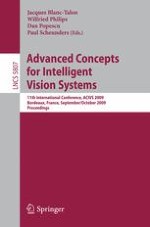2009 | Buch
Advanced Concepts for Intelligent Vision Systems
11th International Conference, ACIVS 2009, Bordeaux, France, September 28–October 2, 2009. Proceedings
herausgegeben von: Jacques Blanc-Talon, Wilfried Philips, Dan Popescu, Paul Scheunders
Verlag: Springer Berlin Heidelberg
Buchreihe : Lecture Notes in Computer Science
